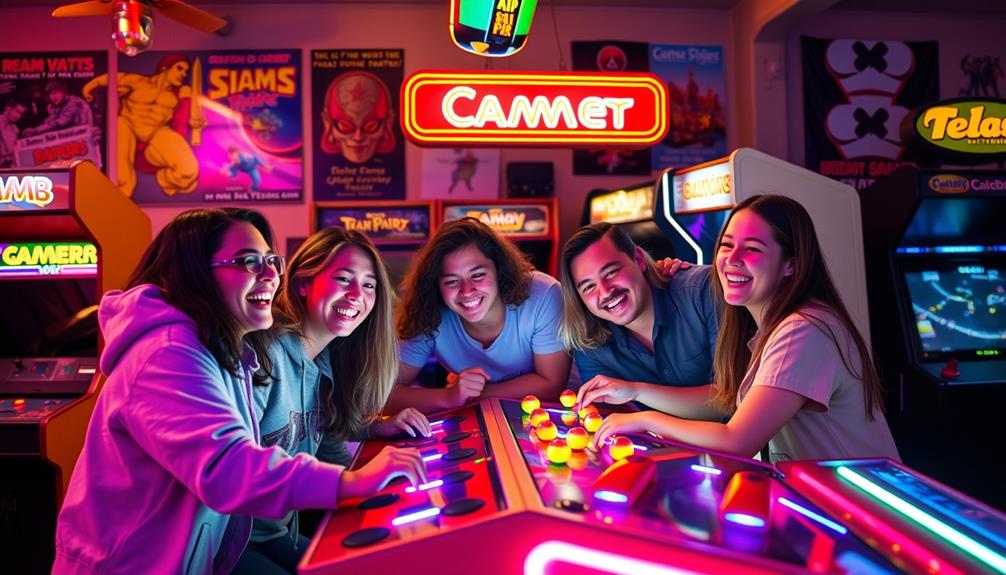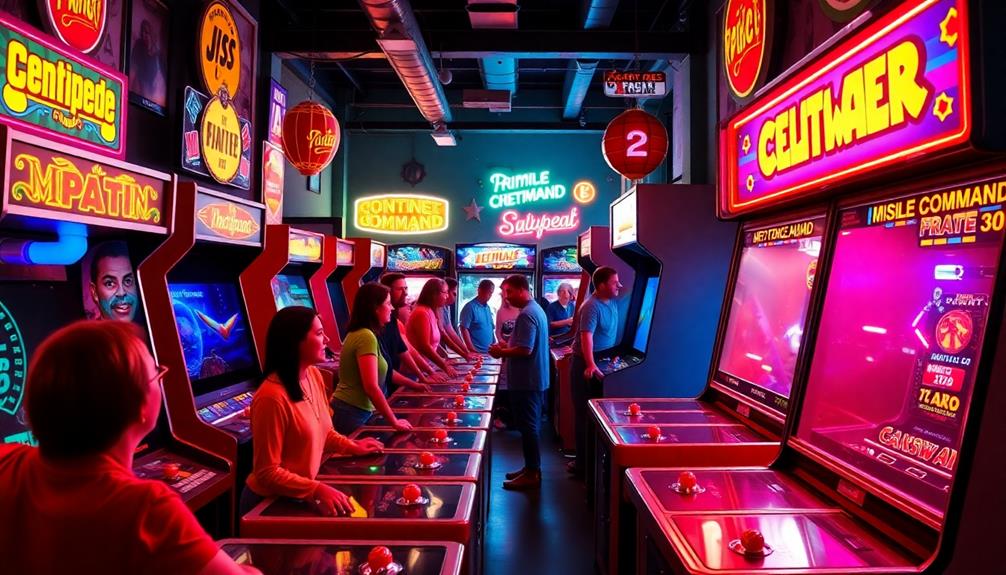If you’re interested in some classic arcade games, you’re in luck! You can compete against friends in fighting games like Street Fighter II or join forces in co-op favorites like Teenage Mutant Ninja Turtles. Don’t overlook shooting games such as House of the Dead and racing titles like Sega Rally. Puzzle games like Tetris will keep you engaged with their strategic gameplay. Additionally, redemption games like Skee-Ball add a fun twist with prizes! The world of arcade games has a lot to offer, and there is so much to learn about their evolution and influence.
Key Takeaways
- Pac-Man: A classic maze-chase game where players eat pellets while avoiding ghosts, first released in 1980.
- Street Fighter II: A revolutionary fighting game from 1991, known for its diverse characters and competitive gameplay.
- Galaga: A popular shooting game from 1981 that defined the shooter genre with its engaging mechanics and challenging levels.
- Teenage Mutant Ninja Turtles: A cooperative beat 'em up game from 1989, allowing up to four players to team up against enemies.
- Tetris: An iconic puzzle game emphasizing strategic block placement, recognized for its simplicity and addictive gameplay.
Popular Arcade Game Genres
Arcade games frequently captivate players with their diverse genres, each offering unique experiences. Among the most popular are fighting games, where titles like *Street Fighter II* and the *Mortal Kombat* series let you engage in competitive battles, showcasing unique characters and special moves. These games not only highlight intense one-on-one battles but also emphasize strategy, timing, and mastering combos, making them iconic staples in gaming history. Diving into arcade game basics and history reveals how fighting games evolved from simple pixelated mechanics to intricate systems that demand precision and skill. Their journey reflects the overall growth of arcade gaming, drawing players into competitive and social experiences that continue to thrive today.
If you're looking for fast-paced action, shooting games like *House of the Dead* and *Time Crisis* utilize lightgun mechanics, allowing you to team up with friends for an adrenaline rush. Additionally, modern arcade machines have integrated advanced technology to enhance gameplay, making the experience even more immersive and enjoyable, with options for best arcade machines for home game rooms available for enthusiasts.
Racing games also stand out, with classics like *Out Run* and *Sega Rally* providing immersive experiences through deluxe arcade machines equipped with force-feedback steering wheels. These games let you feel the thrill of the race while testing your driving skills.
Puzzle games, such as *Tetris* and *Puzzle Bobble*, draw you in with their engaging mechanics, emphasizing strategy and competition. You can challenge your friends for the highest score or simply enjoy the satisfaction of solving puzzles.
Lastly, redemption games like *Skee-Ball* and claw machines reward your efforts with tickets or prizes, adding an extra layer of excitement to your arcade visit. Each genre enhances the arcade experience, making it a delightful destination for all players.
Iconic Classic Arcade Games

When you think of iconic classic arcade games, names like Pac-Man and Donkey Kong probably come to mind. These titles not only entertained players but also shaped gaming culture and influenced countless other games.
Their lasting legacy speaks to the timeless appeal and cultural impact that arcade games have on society. Additionally, the evolution of gaming technology over the years, such as the introduction of pinball machines in the 1930s, played a significant role in the development of arcade gaming as a whole, showcasing the history of pinball machines.
Timeless Gaming Legends
Classic arcade games have left an indelible mark on gaming culture, enchanting players with their engaging mechanics and memorable characters. You can't think of timeless gaming legends without mentioning Pac-Man, the maze-chasing hero who introduced power pellets and sparked a phenomenon in 1980. This game led to a series of sequels and a wave of merchandise that still resonates today, much like how Jennifer Aniston and Brad Pitt maintain a friendly post-divorce connection.
Then there's Donkey Kong, which debuted in 1981 and marked Mario's first appearance. This platformer set the standard for future games and ignited competitive gaming interests. Fast forward to 1991, and you'll find Street Fighter II revolutionizing the fighting game genre with its accessible special moves and iconic character roster, fostering a vibrant arcade gaming community.
Galaga, another classic from 1981, built on its predecessor's success with dive-bombing aliens and complex gameplay mechanics that defined the shooter genre.
And we can't forget Ms. Pac-Man, an improved version of the original that randomized ghost movements and introduced multiple mazes, enhancing the challenge.
These classic arcade games are more than just nostalgic; they shaped the landscape of gaming and remain beloved across generations.
Cultural Impact on Society
While the gaming landscape has evolved dramatically, the cultural impact of iconic classic arcade games remains profound. Games like Pac-Man and Donkey Kong didn't just entertain; they shaped the very foundation of the gaming industry during the Golden Age of arcades.
Pac-Man, released in 1980, became a cultural phenomenon, introducing a non-violent mascot that attracted a broader audience. This paved the way for the genre's growth and revolutionized how games were perceived, much like the advancements seen in best rated pinball machines of 2024.
In 1981, Donkey Kong introduced Mario, an iconic character who'd dominate the gaming world for decades. It defined the platformer genre and influenced countless games that followed.
Fast forward to 1991, and Street Fighter II transformed the fighting game genre, making special moves accessible and creating a competitive community that still thrives today.
These classic arcade games set standards that still resonate. Titles like Ms. Pac-Man and shooters like Galaga and Space Invaders shaped player expectations and influenced game design.
Their legacy goes beyond nostalgia; they laid the groundwork for contemporary gaming culture, proving that the impact of arcade games is as relevant now as it ever was.
Evolution of Arcade Games

The evolution of arcade games showcases a fascinating journey from simple coin-operated machines to complex, immersive experiences. It all began with early skill-based games and progressed into arcade video games, marked by the release of Computer Space, the first arcade game, in 1971.
The golden age of arcades in the 1980s introduced iconic titles like Pac-Man and Donkey Kong, revolutionizing gameplay and culture. This era also highlighted how astrology claims to influence personality traits and attractiveness, as many players connected their favorite games with their zodiac signs, enhancing their enjoyment and self-image.
As we moved into the 1990s, modern technology advanced the medium further with 3D graphics in games such as Virtua Fighter and Virtua Racing, pushing the limits of visual and gameplay experiences.
However, the early 2000s saw a decline in traditional arcades with the rise of home gaming consoles. To adapt, many arcades transformed into Family Entertainment Centers, offering a variety of attractions.
Recently, nostalgia has fueled a resurgence in arcade culture, appealing to nostalgic gamers and new audiences alike. You might find adult-oriented establishments, or barcades, integrating modern technology like virtual reality. This evolution signifies a vibrant blend of past and present, ensuring arcade games remain relevant and exciting.
- Key milestones in arcade history
- The rise of Family Entertainment Centers
- Modern adaptations and technology integration
Multiplayer and Cooperative Experiences

When you gather with friends to tackle iconic team-based titles like "Teenage Mutant Ninja Turtles" or "X-Men," the excitement of cooperative gameplay really shines.
These games not only challenge your skills but also enhance social interactions as you work together to overcome obstacles. The camaraderie built during these gaming sessions can parallel the connections formed through shared interests like body art, such as piercing care and hygiene.
Let's explore how these multiplayer experiences shaped the arcade gaming culture.
Cooperative Gameplay Dynamics
Cooperative gameplay dynamics have transformed the arcade experience, allowing players to unite in their quest for victory. Games like Teenage Mutant Ninja Turtles and The Simpsons offer thrilling opportunities for camaraderie, while classic titles such as X-Men push the boundaries of teamwork.
When you team up with friends, every decision can lead to a higher score and unforgettable moments. Engaging in unique party options can further enhance the fun atmosphere, making these games perfect for gatherings.
Consider these key elements of cooperative gameplay:
- Character Variety: Each player can choose unique characters, like in Golden Axe, where special abilities enhance teamwork.
- Simultaneous Play: With games like X-Men, you can join forces with up to six players, maximizing the fun and strategy.
- Strategic Collaboration: In Ikari Warriors, you must work together to navigate enemy territories, demanding communication and planning.
These arcade games showcase how cooperative gameplay not only increases engagement but also fosters a sense of community.
Whether you're battling foes as the Teenage Mutant Ninja Turtles or cracking jokes with The Simpsons, cooperative dynamics elevate the experience, making it memorable for everyone involved.
Iconic Team-Based Titles
Arcade enthusiasts often cherish iconic team-based titles that have defined multiplayer and cooperative experiences. Games like Teenage Mutant Ninja Turtles (1989) let you and three friends jump into the action, controlling your favorite turtles while enjoying vibrant visuals that mirror the beloved cartoon.
Similarly, The Simpsons (1991) offers a hilarious four-player beat 'em up where you can take on the roles of iconic characters like Homer and Marge, all while engaging in fun cooperative gameplay. These games not only emphasize teamwork but also challenge players to navigate complex scenarios, reflecting the importance of philosophical exploration in enhancing shared experiences.
X-Men (1992) elevated multiplayer experiences with the ability for up to six players to join forces, showcasing iconic characters and powers on a dual-screen setup that kept the action flowing.
If you prefer a fantasy setting, Golden Axe (1989) enables cooperative play with unique magical abilities that enhance the teamwork aspect.
Finally, Gauntlet (1985) pioneered cooperative dungeon crawling, allowing up to four players to choose different character classes, emphasizing strategy and collaboration.
These titles not only deliver thrilling gameplay but also create lasting memories through teamwork and shared experiences, making them unforgettable staples in arcade history.
Innovative Gameplay Mechanics

Innovative gameplay mechanics have always pushed the boundaries of what players can experience in arcade games. From the early days of coin-operated machines to today's action gaming staples, these mechanics have transformed how you interact with the game genre.
Understanding the importance of proper hamster care can also enhance the gaming experience, as it promotes a balanced lifestyle for players.
Consider these groundbreaking features:
- Complex Wave-Based Gameplay: In Defender (1981), you navigate through intricate waves of enemies, setting a new standard for arcade shooters.
- Dual-Stick Controls: Ikari Warriors (1986) introduced cooperative gameplay, allowing you to maneuver through enemy lines with precision, enhancing the challenge and camaraderie.
- Light Gun Mechanics: Time Crisis II (1997) perfected this with a foot pedal for cover, adding a strategic layer to the fast-paced shooting experience.
These innovative gameplay mechanics not only shaped the first video games but also influenced future designs.
Guitar Freaks (1998) shifted the focus to rhythm through plastic instrument gameplay, while Mercs (1990) captivated players with cooperative up-scrolling shooting.
Each of these titles demonstrates how creativity can elevate the gaming experience, keeping players engaged and enthusiastic for more.
Cultural Impact of Arcade Games

The influence of arcade games extends far beyond their screens, shaping culture in significant ways. Games like Pac-Man and Donkey Kong have become cultural icons, not only defining gameplay mechanics but also inspiring movies, merchandise, and fashion. Their nostalgic appeal draws you in, reminding you of simpler times spent in arcades, filled with your favorite arcade games.
Additionally, the rise of AI-Powered Virtual Reality in E-Learning has begun to blend gaming with educational experiences, further broadening the impact of games on diverse audiences. The introduction of non-violent titles like Pac-Man broadened the audience for gaming, attracting players of all ages and diversifying the arcade experience.
Meanwhile, games such as Street Fighter II and Teenage Mutant Ninja Turtles fostered competitive gaming environments, leading to tournaments that built a dedicated community around arcade gaming.
Today, the resurgence of classic arcade games in venues like barcades blends socializing and gaming, catering to adult audiences looking for fun and nostalgia. Rhythm action games like Dance Dance Revolution have added another layer, encouraging physical activity and social interaction, thereby shaping a new facet of arcade culture centered on fitness and group play.
Modern Trends in Arcade Gaming

As technology evolves, modern arcade gaming is embracing exciting trends that keep players engaged and entertained. You'll find that today's arcades are much more than just rows of arcade machines; they've transformed into multifaceted entertainment hubs.
One major trend is the rise of virtual reality experiences. Multiplayer options like Hologate and Omni Arena are enhancing social interaction among players, making gaming a more communal activity.
Additionally, many arcades are incorporating mobile gaming to attract a younger audience. This shift caters to changing entertainment preferences and keeps the gaming experience fresh.
Consider these modern arcade gaming trends:
- Themed gaming environments that create immersive experiences
- E-sports tournaments that draw large crowds and cultivate a competitive spirit
- Adult-oriented arcades, or "barcades," that combine nostalgic gaming with social atmospheres
These trends show how arcades are evolving, providing unique experiences that cater to a diverse demographic.
The blend of technology and social engagement guarantees that arcade gaming remains relevant and exciting in today's entertainment landscape.
Frequently Asked Questions
What Is the Most Common Arcade Game?
When you think about the most common arcade game, Pac-Man immediately comes to mind. Its iconic status and cultural impact have made it a staple in arcades, enchanting players since its release in 1980.
Which Is the Best Arcade Game?
Did you know that Street Fighter II generated over $1 billion in quarters? When you ask which is the best arcade game, many argue it's Street Fighter II for its groundbreaking gameplay and character diversity.
What Is Considered an Arcade Game?
An arcade game is any coin-operated machine you find in amusement centers, featuring skill-based gameplay or chance elements. These games often involve competition and replay value, making them entertaining for players of all ages. Arcade games are a popular form of entertainment and can be found in locations such as bowling alleys, bars, and shopping centers. In recent years, arcade game statistics have shown a resurgence in popularity, with new technology and innovative game design attracting a new generation of gamers. Many people enjoy the nostalgic appeal of classic arcade games, while others are drawn to the competitive nature of modern arcade games. Arcade game statistics indicate that these machines continue to be a profitable and engaging form of entertainment for both casual players and dedicated enthusiasts.
What Is the Highest Selling Arcade Game of All Time?
You might be surprised to learn that the highest selling arcade game of all time is *Pac-Man*. Since its 1980 release, it's sold over 400,000 cabinets and generated more than $2.5 billion in revenue.
Conclusion
As you step into the vibrant world of arcade games, the sounds of beeping machines and the flashing lights pull you in like a siren's call. From the classic nostalgia of Pac-Man to the thrilling multiplayer battles of modern titles, each game invites you to release your competitive spirit. Whether you're plunging into pixelated adventures or teaming up with friends, the arcade experience ignites a fire of excitement that keeps you coming back for more. Immerse yourself and play!









